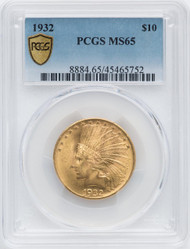1932 $10 Indian Gold Coins
Posted by Bullion Shark on Sep 16th 2022
1932 $10 Indian Gold Coins
After President Theodore Roosevelt commissioned famed American sculptor Augustus Saint-Gaudens in 1905 to put his artistic skills at work redesigning American coinage, Saint-Gaudens’ health continued to deteriorate. He had planned to redesign everything from the cent to the $20 gold eagle, but he was only able to complete work for the $10 and $20 gold coins.
And those coins, which were not actually struck until after his death in 1907, were completed thanks to modelling work done by Adolph Weinman, who studied and worked with Saint-Gaudens and was also part of the Beaux-Arts generation of artists strongly influenced by French art and architecture. In addition, chief engraver Charles Barber also made some refinements to the coin such as lowering its relief so that it could be struck for commerce and stack better,
While the $10 coin, which is almost as popular with collectors of pre-1933 U.S. gold coins as the $20 gold coin Saint-Gaudens designed, is known as the Indian Head eagle, its obverse design does not feature a Native American. Instead, it is an image of Liberty wearing a Native headdress emblazoned with “Liberty”, and the portrait on the coin is based on a combination of an earlier study the artist had done of Nike, the Greek goddess of victory for his famous statue in New York City of Civil War General William Tecumseh Sherman. It is also believed to have been based on a portrait of Saint-Gaudens’ mistress, Davida Clark.
The reverse comes straight from the design of a perched eagle that appears on the 1905 inauguration medal the artist prepared for Roosevelt, which would later be used by Bela Lyon Pratt on his $2.50 and $5 gold coins.
When the coins were struck and entered circulation in December 1907, reaction to the new motifs was very positive and stressed how much the dignified pose and refined character of Liberty on the coin and the way in which the design of the feathers of the headdress went all the way to the coin’s edge resembled that of ancient Greek coinage. That is hardly surprising since Roosevelt had been inspired by Greek coinage that he saw at the Smithsonian as the standard to which the new American coinage should strive for.
On the other hand, the eagle motif on the reverse, though not an original one, did give the coin its American character.
1932 $10 Gold Coins
Compared to $20 double eagles, which are quite plentiful in mint state for many issues of that series, the $10 gold series is generally more rare and scarce in uncirculated condition.
1932 is considered to be the biggest exception to that trend since it is plentiful in mint state grades (with about 125,000 examples that have survived according to Bowers) through MS63 And that is related to the fact that its original mintage of 4,463,000 is the highest of the series, which is odd since the coin was produced several years into the Great Depression when the demand for coinage was low, especially for higher denominations.
But back in the 1930s, this coin was considered to be scarce. As Dave Bowers explains, even though this was the period (1933-1934) when Americans were asked to turn in their gold coins to the government, many apparently did the opposite and acquired examples at local banks. However, of the one or two million examples paid out at banks, most are believed to have been sent overseas for international trade. Most of the others were melted after the famous Executive Order of 1933. But over the decades, most of those 1932 $10 coins have made their way back to the U.S.
Today this date is ideal for a type collection and widely purchased in nice mint state examples for just that purpose. But starting at MS64 it is not so common and gets more expensive as the grades get higher.
In MS62, the current PCGS price guide value for this issue is $1700, while in MS63 it runs $1850, jumping to $2750 in MS64, $5500 in MS65, $12,500 in MS66 and a whopping $50,000 in the top grade of MS67.
The record for an actual auction sale is $38,400 for an MS67 in June.
Population numbers help explain this price structure as there are 14,000 examples in MS64, but only 1850 in MS65, just 164 in MS66 and one in MS67 – all based on PCGS reporting data.
Keep in mind that while plentiful in mint state and typically well struck with good lustre, 1932 Indian $10 coins also tend to have plenty of large bag marks, which is another reason that really choice specimens are hard to come by.
MS65 and MS64+ Coins In Stock Now
Fortunately, we currently have a mini-hoard of NGC and PCGS graded MS65 examples of this popular issue that would be great for a higher end type set that are priced well below the current PCGS valuation. There is also a nice PCGS MS64+ with green CAC sticker that is also a great deal. Check out the full inventory of $10 gold coins.


